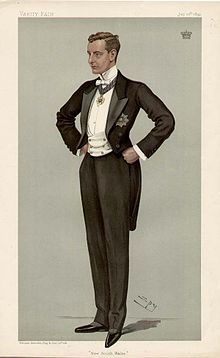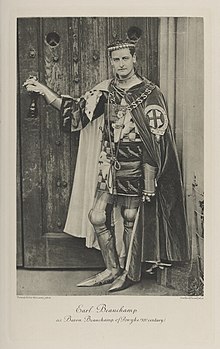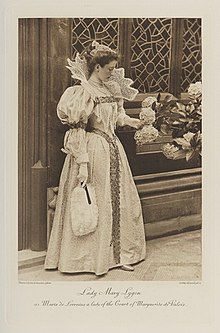Social Victorians/People/Beauchamp

Also Known As
[edit | edit source]- Family name: Lygon
- Earl Beauchamp
- Viscount Elmley
- William Lygon, 7th Earl Beauchamp ( – 1891)[3]
Acquaintances, Friends and Enemies
[edit | edit source]Organizations
[edit | edit source]- Liberal Party
Timeline
[edit | edit source]1897 July 2, Friday, William Lygon, 7th Earl Beauchamp, and his sister Lady Mary Lygon attended the Duchess of Devonshire's fancy-dress ball at Devonshire House. He and Lettice Grosvenor Lygon had not yet married. (William Lygon, 7th Earl Beauchamp is #60 on the list of people who were present; Lady Mary Lygon is #547.)
1899 July 20, a caricature portrait (above right) of "New South Wales" (William Lygon, Lord Beachamp) by Leslie Ward ("Spy") appeared in the 20 July 1899 Vanity Fair, as Number 710 in its "Statesmen" series.[4]
1902 July 26, William Lygon married Lettice Grosvenor at Eccleston, Cheshire.[5]
1931, William Lygon's homosexuality was revealed publicly.[3]
Costume at the Duchess of Devonshire's 2 July 1897 Fancy-dress Ball
[edit | edit source]
William Lygon, 7th Earl Beauchamp
[edit | edit source]
William Lygon, 7th Earl Beauchamp attended the Duchess of Devonshire's fancy-dress ball.
Thomas Bennett & Sons's portrait (left) of "William Lygon, 7th Earl Beauchamp as Baron Beauchamp of Powyke (XIV Century)" in costume is #154 in the album presented to the Duchess of Devonshire and now in the National Portrait Gallery.[6] The printing on the portrait says, "Earl Beauchamp as Baron Beauchamp of Powyke (XIV Century)."[7]
The caricature portrait of the Earl of Beauchamp (above right) shows what he looked like out of costume in the late 1890s.
William, Earl Beauchamp seems to have been dressed as John Beauchamp, 1st Baron Beauchamp ( – April 1475), based on the description of him as Baron Beauchamp of Powyke (or Powick).[8] The coat of arms of Sir John Beachamp is above, right.
His costume was made by "Simmons and Sons, of the Haymarket."[9]:p. 8, Col. 2a
Newspaper Accounts
[edit | edit source]The newspaper accounts do not agree on what he wore.
- "Knight 1400. Suit of steel armour, with embroidered heraldic tabard and blue velvet mantle reaching to the ground, with arms of the Garter embroidered on the shoulder and a gilt crown with pearls."[9]:p. 8, Col. 1a
- "Lord Beauchamp wore the dress in which the first Lord Beauchamp was painted."[9]:p. 7, Col. 4c
- "Earl Beauchamp was clad in the steel armour of a Knight of the Fourteenth Century, with embroidered heraldic tabard, and blue velvet mantle reaching to the ground, with arms of the Garter embroidered on the shoulder, and a gilt crown with pearls."[10]:p. 3, Col. 4b
- "Earl of Beauchamp (knight, 1400), steel armour with embroidered heraldic tabard; blue silk velvet mantle with arms of the Garter embroidered on shoulder; gilt crown, with pearls."[11]:p. 34, Col. 1b
- "EARL BEAUCHAMP, a Knight of 1400, wore a suit of steel armour with embroidered heraldic tabard, and blue velvet mantle reaching to the ground, with the army of the Garter embroidered on the shoulder, and a gilt crown with pearls."[12]:Col. 3a
The London Daily News reports that he was one of the Knights of the Round Table, but no other list of the Round Table Knights includes him.
- Along with the other knights of the Round Table, he wore a "white satin tabard, royal blue cloak embroidered in scarlet and gold over chain mail armour, with helmet, spurs, and two-handed sword complete, each with his own crest embroidered on his tabard."[13]:p. 5, Col. 7a

Lady Mary Lygon
[edit | edit source]Lady Mary Lygon was at the ball attending the Duke and Duchess of York, with Charles Cust.
Thomas Bennett & Sons's portrait (right) of "Lady Mary Hepburn-Stuart-Forbes-Trefusis (née Lygon) as Marie de Lorraine, a lady of the Court of Marguerite de Valois" in costume is #153 in the album presented to the Duchess of Devonshire and now in the National Portrait Gallery.[6] The printing on the portrait says, "Lady Mary Lygon as Marie de Lorraine, a lady of the Court of Marguerite de Valois."[14]
One Marie de Lorraine (1515–1560), probably the most likely one if Lady Mary Lygon is being historically accurate, is Mary of Guise.[15] Her daughter was Mary, Queen of Scots, who married Frederic II of France, brother of Marguerite de Valois (1553–1615).[16] No image of Mary of Guise exists with a collar similar to the one Lady Mary is wearing in this portrait, but Margaret of Valois (whom the Princess of Wales was dressed as) did wear similar collars.
Demographics
[edit | edit source]- Nationality: British[3]
Family
[edit | edit source]- Frederick Lygon, 6th Earl Beauchamp (10 November 1830 – 19 February 1891)[1]
- Lady Mary Catherine Stanhope (3 February 1844 – 30 June 1876)[17]
- Lady Mary Lygon (26 February 1869 – 12 September 1927)
- Lady Susan Lygon (24 May 1870 – 28 January 1962)
- William Lygon, 7th Earl Beauchamp (20 February 1872 – 15 November 1938)
- Lieutenant Hon. Edward Hugh Lygon (17 July 1873 – 23 March 1900)
- Lady Margaret Lygon (8 October 1874 – 12 December 1957)
- Lady Emily Annora Charlotte Pierrepont (16 March 1853 – 11 May 1935)[18]
- Lt.-Col. Hon. Robert Lygon (9 August 1879 – 13 January 1952)
- Lady Agnes Lygon (1880–1960)
- Lady Maud Lygon (1882 – 27 December 1962)
- Hon. Henry Lygon (1884–1932)
- Lady Mary Lygon (26 February 1869 – 12 September 1927)[19]
- Lt.-Col. Hon. Henry Walter Hepburn-Stuart-Forbes-Trefusis (8 December 1864 – 2 June 1948)[20]
- Henry Trefusis (4 June 1908 – 27 April 1975)
- William Lygon, 7th Earl Beauchamp (20 February 1872 – 14 November 1938)[3]
- Lettice Mary Elizabeth Grosvenor (25 December 1876 – 28 July 1936)[5]
- William Lygon, 8th Earl Beauchamp (3 July 1903 – 3 January 1979)
- Hon. Hugh Patrick Lygon (2 November 1904 – 19 August 1936)
- Lady Lettice Lygon (16 Jun 1906–1973)
- Lady Sibell Lygon (10 October 1907 – 31 October 2005)
- Lady Mary Lygon (12 February 1910 – 27 September 1982)
- Lady Dorothy Lygon (22 February 1912 – 13 November 2001)
- Hon. Richard Edward Lygon (25 December 1916 – 1970)
Questions and Notes
[edit | edit source]- William Lygon, 7th Earl Beauchamp "is often assumed to be the model for the character Lord Marchmain in Evelyn Waugh's novel Brideshead Revisited."[3] His second son, Hugh Patrick Lygon, is "said to be the model for Sebastian in Brideshead Revisited," Lord Marchmain's son.[3]
- William Lygon, 7th Earl Beauchamp was exposed by his brother-in-law Bendor Grosvenor, 2nd Duke of Westminster to King George V and Queen Mary as homosexual (in 1931).[21]
- According to the Morning Post and the Gentlewoman, the Knights of the Round Table were George, Baron Rodney; Hon. R. Grosvenor; Seymour Henry Bathurst, 7th Earl Bathurst; and Hon. Grosvenor Hood.[9]:8, Col. 1b [11]:40, Col. 1c According to the Daily News, the Knights of the Table Round were "Lord Ashburton, Lord Rodney, Lord Bathurst, Lord Ampthill, and Lord Beauchamp";[13]:5, Col. 7a the newspaper accounts disagree on Lord Beauchamp in particular. George, Baron Rodney was 40 at the time of the ball; Seymour Henry Bathurst, 7th Earl Bathurst was nearly 33; Hon. Grosvenor Hood was 29; Lord Francis Ashburton was nearly 31; Lord Ampthill was 28; Lord Beauchamp was 25.
Footnotes
[edit | edit source]- ↑ 1.0 1.1 "Frederick Lygon, 6th Earl Beauchamp." "Person Page". www.thepeerage.com. Retrieved 2020-10-11. https://www.thepeerage.com/p1407.htm#i14067.
- ↑ "Person Page". www.thepeerage.com. Retrieved 2021-09-15. https://www.thepeerage.com/p11117.htm#i111164.
- ↑ 3.0 3.1 3.2 3.3 3.4 3.5 "William Lygon, 7th Earl Beauchamp". Wikipedia. 2020-10-08. https://en.wikipedia.org/w/index.php?title=William_Lygon,_7th_Earl_Beauchamp&oldid=982467595.
- ↑ "List of Vanity Fair (British magazine) caricatures (1895–1899)". Wikipedia. 2024-01-14. https://en.wikipedia.org/w/index.php?title=List_of_Vanity_Fair_(British_magazine)_caricatures_(1895%E2%80%931899)&oldid=1195518024. https://en.wikipedia.org/wiki/List_of_Vanity_Fair_(British_magazine)_caricatures_(1895%E2%80%931899).
- ↑ 5.0 5.1 "Lady Lettice Mary Elizabeth Grosvenor." "Person Page". www.thepeerage.com. Retrieved 2020-10-11.
- ↑ 6.0 6.1 "Devonshire House Fancy Dress Ball (1897): photogravures by Walker & Boutall after various photographers." 1899. National Portrait Gallery https://www.npg.org.uk/collections/search/portrait-list.php?set=515.
- ↑ "Earl Beauchamp as Baron Beauchamp." Diamond Jubilee Fancy Dress Ball. National Portrait Gallery https://www.npg.org.uk/collections/search/portrait/mw158517/William-Lygon-7th-Earl-Beauchamp-as-Baron-Beauchamp-of-Powyke-XIV-Century.
- ↑ "John Beauchamp, 1st Baron Beauchamp (fifth creation)". Wikipedia. 2021-06-16. https://en.wikipedia.org/w/index.php?title=John_Beauchamp,_1st_Baron_Beauchamp_(fifth_creation)&oldid=1028915062. https://en.wikipedia.org/wiki/John_Beauchamp,_1st_Baron_Beauchamp_(fifth_creation).
- ↑ 9.0 9.1 9.2 9.3 "Fancy Dress Ball at Devonshire House." Morning Post Saturday 3 July 1897: 7 [of 12], Col. 4a–8 Col. 2b. British Newspaper Archive https://www.britishnewspaperarchive.co.uk/viewer/bl/0000174/18970703/054/0007.
- ↑ “The Ball at Devonshire House. Magnificent Spectacle. Description of the Dresses.” London Evening Standard 3 July 1897 Saturday: 3 [of 12], Cols. 1a–5b [of 7]. British Newspaper Archive https://www.britishnewspaperarchive.co.uk/viewer/bl/0000183/18970703/015/0004.
- ↑ 11.0 11.1 “The Duchess of Devonshire’s Ball.” The Gentlewoman 10 July 1897 Saturday: 32–42 [of 76], Cols. 1a–3c [of 3]. British Newspaper Archive https://www.britishnewspaperarchive.co.uk/viewer/bl/0003340/18970710/155/0032.
- ↑ “Additional Costumes Worn at the Duchess of Devonshire’s Fancy Ball.” The Queen, The Lady’s Newspaper17 July 1897, Saturday: 63 [of 97 BNA; p. 138 on the print page], Col. 2a–3a [3 of 3 cols.]. British Newspaper Archive https://www.britishnewspaperarchive.co.uk/viewer/BL/0002627/18970717/283/0064.
- ↑ 13.0 13.1 "Duchess of Devonshire's Fancy Ball. A Brilliant Spectacle. Some of the Dresses." London Daily News Saturday 3 July 1897: 5 [of 10], Col. 6a–6, Col. 1b. British Newspaper Archive https://www.britishnewspaperarchive.co.uk/viewer/bl/0000051/18970703/024/0005 and https://www.britishnewspaperarchive.co.uk/viewer/BL/0000051/18970703/024/0006.
- ↑ "Lady Mary Lygon as Marie de Lorraine." Diamond Jubilee Fancy Dress Ball. National Portrait Gallery https://www.npg.org.uk/collections/search/portrait/mw158516/Lady-Mary-Hepburn-Stuart-Forbes-Trefusis-ne-Lygon-as-Marie-de-Lorraine-a-lady-of-the-Court-of-Marguerite-de-Valois.
- ↑ "Mary of Guise". Wikipedia. 2021-10-18. https://en.wikipedia.org/w/index.php?title=Mary_of_Guise&oldid=1050525937. https://en.wikipedia.org/wiki/Mary_of_Guise.
- ↑ "Margaret of Valois". Wikipedia. 2021-10-31. https://en.wikipedia.org/w/index.php?title=Margaret_of_Valois&oldid=1052890581. https://en.wikipedia.org/wiki/Margaret_of_Valois.
- ↑ "Lady Mary Catherine Stanhope." "Person Page". www.thepeerage.com. Retrieved 2020-10-11.
- ↑ "Lady Emily Annora Charlotte Pierrepont." "Person Page". www.thepeerage.com. Retrieved 2020-10-11.
- ↑ "Lady Mary Lygon." "Person Page". www.thepeerage.com. Retrieved 2020-10-11.
- ↑ "Lt.-Col. Hon. Henry Walter Hepburn-Stuart-Forbes-Trefusis." "Person Page". www.thepeerage.com. Retrieved 2020-10-11.
- ↑ "Hugh Grosvenor, 2nd Duke of Westminster". Wikipedia. 2021-08-10. https://en.wikipedia.org/w/index.php?title=Hugh_Grosvenor,_2nd_Duke_of_Westminster&oldid=1038094493. https://en.wikipedia.org/wiki/Hugh_Grosvenor,_2nd_Duke_of_Westminster.
